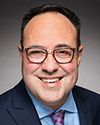What I can share with you is that we did see people leaving. Some of it was through programs.
You have to understand that 66% of our cost is people. We had to take very hard decisions at Nav Canada to reduce our workforce by 12.7%. That didn't affect anybody directly in operations, other than we offered some incentives to retire early. Those people were going to retire anyway in a short time frame, or there were chances of their retiring in a short time frame. These people left. Other people who left through normal attrition, retirement, or things like that, we didn't necessarily replace at the time.
It is important to note that we have rehired lots of these people. We have called back and rehired 50 people, actually.
During that time period, what really didn't help us was that because of COVID-19, we were unable to train for a number of different reasons. The first one was for the safety of our employees and ensuring the service delivery. As you can imagine, a trainee and an OJI work very closely with one another. We didn't want to chance the spread of COVID-19. In addition to that, we had such a reduction in traffic that it was very hard to justify how we could qualify people with the low level of traffic. It was questioned both by the union as well as by Transport Canada.
Unfortunately, we had to let those trainees go. We didn't make any headway during that time.
We have since rehired most of these trainees. In the last year we qualified about 100 of them. As I said before, we still have about 250 trainees in the system.
Yes, people left, and then we—






